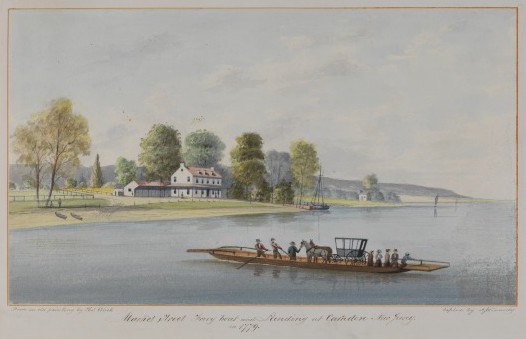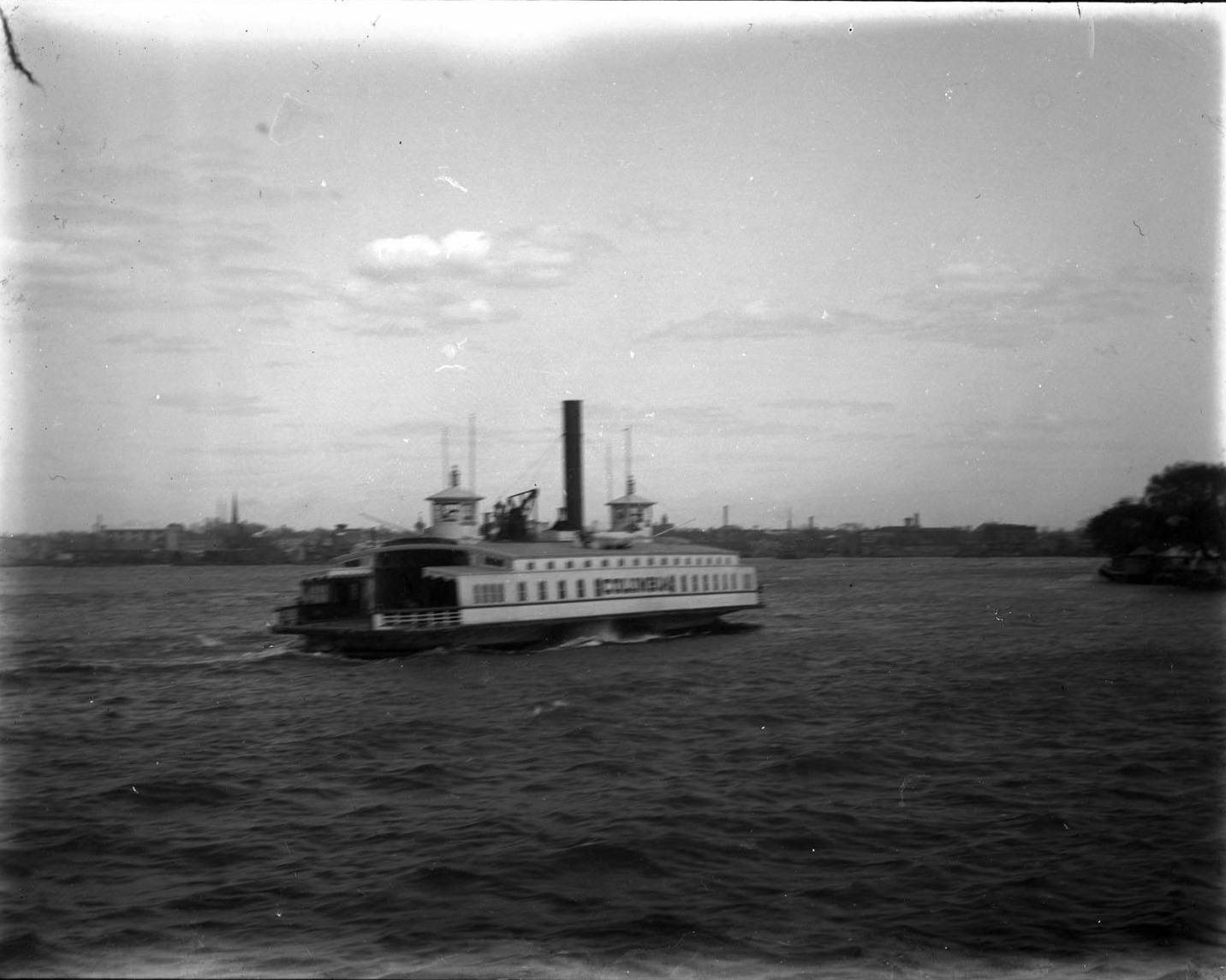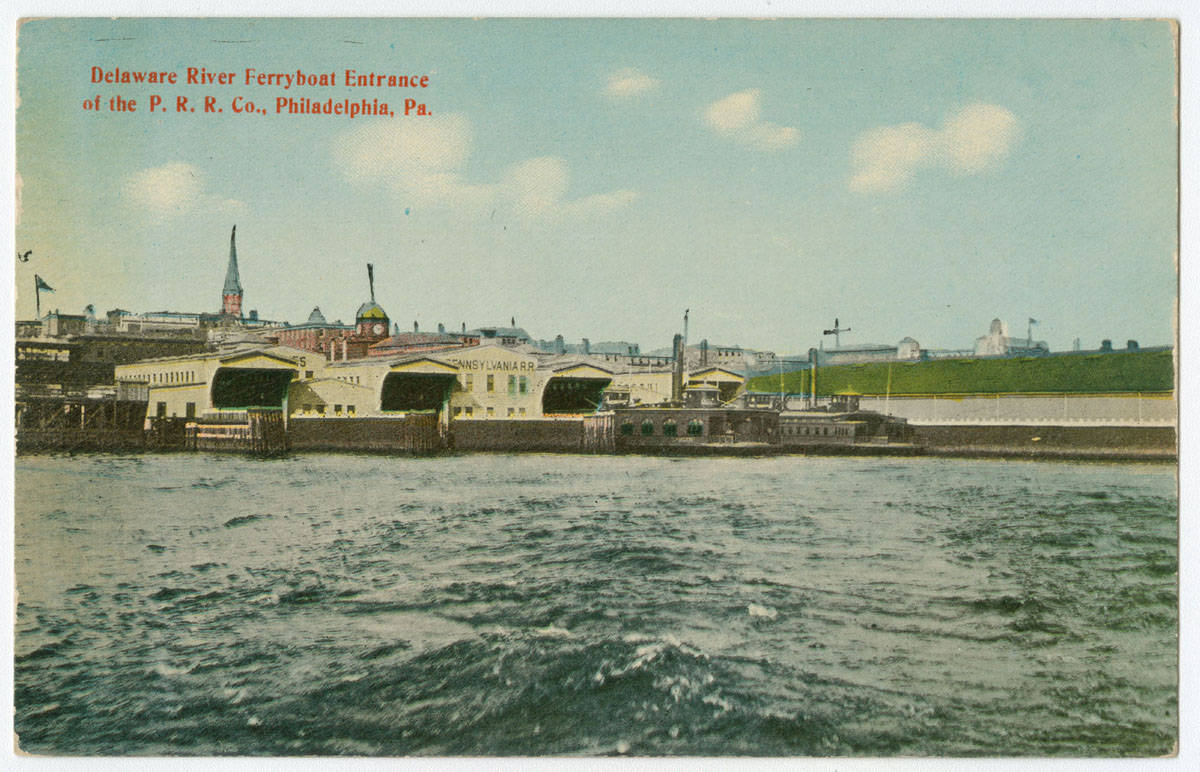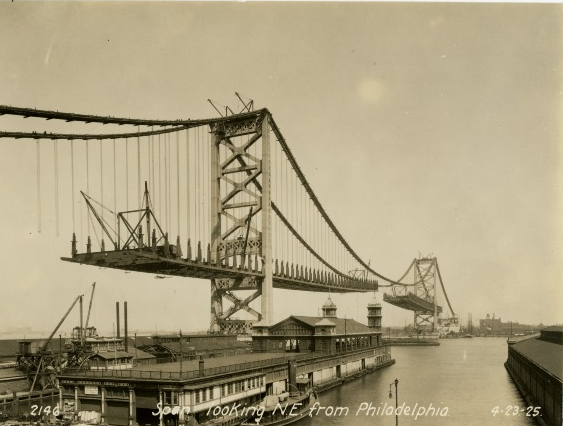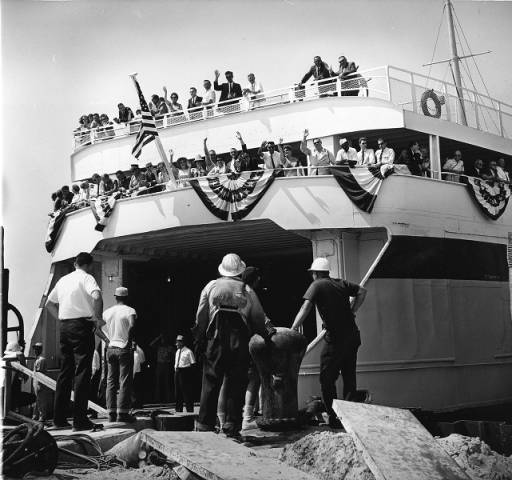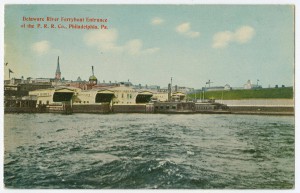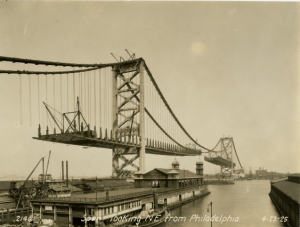Ferries
By Stephen Nepa
Essay
Long before bridges, trestles, and elevated expressways, the people and products of Greater Philadelphia required a network of ferries to traverse the region’s numerous waterways. Once ubiquitous on the area’s rivers, ferries were economic necessities that were phased out over time as industry changed and transportation improved.

Until the advent of steam and internal combustion technologies, ferries required man, horse, or mule power. Swedish colonists operated the region’s first ferries in the 1660s along the Christina River in the region that became Delaware. By 1700, several entrepreneurs operated ferries across the Delaware River between growing riverfront settlements in Pennsylvania and New Jersey. As the British consolidated their territorial holdings in the late 1600s, ferries required royal authority to operate. In the Lower Counties (later the state of Delaware), Governor Francis Lovelace (1621-75) chartered the first ferry service on the Christina north of present-day Newport in 1669 with an additional crossing established over Brandywine Creek in 1689; the peninsular land mass between these two ferries eventually became central Wilmington, Delaware (est.1731). In 1724, Governor William Keith (1669-1749) granted license to a ferry on the Delaware River between New Castle, Delaware, and Salem, New Jersey, which allowed Salem residents to worship across the river at Old Swedes Church.
Ferry operations also led to the formation of towns and cities. In order to connect a fledgling Philadelphia with the farms of West New Jersey, William Royden received a ferry charter from Gloucester County in 1688. By 1695, the Cooper family, having settled in 1681 at a site that became known as Pyne Point, assumed control of Royden’s ferry. William Cooper began additional service from New Jersey to Philadelphia in 1708; by the mid-1760s, his great-grandson Daniel built Parson’s Hotel at the landing, which became known as the town of Cooper’s Ferry. Nearby Kaighnton and Fettersville (an early Black community) also were served by ferries. In 1828, the three towns merged and were incorporated as the city of Camden.
Schuylkill River Ferry, 1685
In Philadelphia, the colonial assembly addressed the need for ferries just after the city’s founding. Records indicate that Philip England began operating the first, or lower, ferry on the Schuylkill River in 1685 between High Street and newly created roads to Darby and Merion. The upper ferry at Spring Garden Street, operated by William Powel, commenced in 1692 and after 1730, when Lancaster Pike opened, increased traffic prompted a third, or middle, ferry. These crossings, made by pulling ropes, were difficult, and in 1774 the colonial assembly voted to construct a bridge over the river. Yet it was not until 1776, as a military necessity, that a floating bridge was erected. Ferries also spurred travel-related enterprises such as hotels, taverns, and slips. George Gray (1725-1800), who had assumed control of England’s ferry in 1744, also operated a floating bridge and popular pleasure garden (Gray’s Tavern and Inn) following the American Revolution.
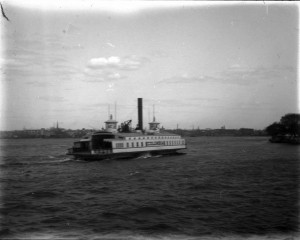
While ferries connected cities to their hinterlands, a growing system of toll roads, pikes, and longer-range boats connected with them, allowing a fluid traversal of the entire area and to distant points such as New York and Baltimore. In his autobiography, Benjamin Franklin (1706-90) recounted his journey from Boston to Philadelphia, much of it by ferry. North of Philadelphia, significant ferry enterprises linked Mercer County, New Jersey, and Bucks County, Pennsylvania. Between 1675 and the outbreak of the American Revolution, Trenton established the Lower, Middle, and Upper Ferry crossings over the Delaware. The Middle Ferry connected with a stagecoach line to New Brunswick and downriver service to Philadelphia.
Ferries between Pennsylvania and New Jersey played key roles in the American Revolution, most famously when George Washington (1732-99) and his army crossed the Delaware on December 25, 1776, at McConkey’s Ferry. Earlier that year, tavernkeeper and ferry operator John Coryell denied British soldiers passage on his ferry between Lambertville, New Jersey, and New Hope, Pennsylvania, as General Charles Cornwallis (1738-1805) pursued the Continental Army into Pennsylvania. During the conflict, Trenton’s Lower Ferry earned the nickname “Continental Ferry” as proprietor Elijah Bond offered active American soldiers reduced rates. While the British occupied Philadelphia (September 1777–June 1778), American spies disguised as farmers used ferries at the Schuylkill River (including Gray’s Ferry) to slip in and out of the city.
The Rise of Bridges
During the early 1800s, bridges began to replace ferries at narrow crossing points, such as Trenton; Morrisville, Pennsylvania.; and Newport, Delaware. Ferries remained important carriers at wider crossings, however, and in the early industrial period they exchanged man, mule, or horsepower for steam. In 1810, James Bispham piloted the first steam ferry on the Delaware from Camden’s Cooper Street to Philadelphia’s Market Street. By the 1830s several steam ferries, some equipped with passenger cabins, plied the region’s crowded waters. In addition to ferries, larger packet boats (carrying goods and people) ran along the Delaware River to the bay with stops at Chester, Wilmington, and New Castle. Safety, however, remained an issue as ferries traversing the Delaware’s wider points contended with storms, currents, fog, and, in winter, ice sheets that made crossings treacherous if not impossible.
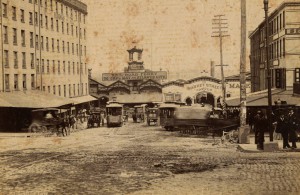
Overcrowded boats and docks at peak hours as well as the risks of bad weather made the railroad a preferable and more efficient alternative to ferries. Yet because no bridge crossed the width of the Delaware between Philadelphia and Camden until 1926, ferries provided a vital connection for rail passengers bound for New York and points north. Beginning in the 1850s many companies, including the Camden and Atlantic (C&A) Railroad and the Pennsylvania Railroad (PRR), acquired ferries to augment their existing lines. In 1854, the C&A purchased the Cooper family’s operations and offered more frequent service between Camden and Philadelphia. Though the region’s rail lines expanded throughout the nineteenth century, independent ferry operators, including Philadelphia’s Reeves and Knisell; Camden’s English, Clements, and Burr; and shipbuilder William Cramp’s (1807-79) line for his workers, remained in operation on the Delaware River. Ferries also inspired the imagination. Admiring a sunset from the Camden waterfront in 1882, Walt Whitman (1819-92) described the ferry Wenonah, “as pretty an object as you could wish to see, lightly and swiftly skimming along, all trim and white, cover’d with flags, transparent red and blue, streaming out in the breeze.”
Autos Speed Demise of Ferries
By 1900, wooden and/or suspension bridges connected towns along the Delaware River from Bristol, Pennsylvania, north to New Hope. South of Bristol, ferries continued to ply the river, with only the Delair Railroad Bridge (1896) linking Philadelphia and New Jersey. However, the arrival of automobiles in the early 1900s created demand for better crossings. In 1922, construction commenced on the Delaware River Bridge (renamed the Benjamin Franklin Bridge in 1955). When completed four years later, the new span led to the closure of many ferries and demolition of their riverfront facilities. This pattern continued in 1929 with the opening of the Tacony-Palmyra Bridge and in the 1950s with the opening of the Delaware Memorial and Walt Whitman Bridges. The Chester-to-Bridgeport, New Jersey, Ferry operated until the mid-1970s, providing a crucial link between Greater Philadelphia and points along the Jersey Shore. However, when the Commodore Barry Bridge opened in 1974, its days were numbered.
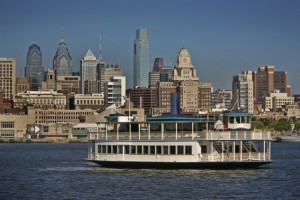
While automobiles, buses, and trains handled the majority of Greater Philadelphia’s transportation needs after the 1970s, certain ferries connecting points inaccessible by bridge remained in operation into the twenty-first century. These included two lines running from Delaware City, Delaware, to Pea Patch Island and Salem, New Jersey, as well as the Cape May, New Jersey-to-Lewes, Delaware, Ferry, which between 1964 and 2014 carried more than 14 million cars and 43 million passengers across the seventeen-mile mouth of Delaware Bay. In the first two decades of the twenty-first century, with considerable investment and development along the Philadelphia and Camden waterfronts, the RiverLink Ferry provided service between points such as, the Adventure Aquarium on the Camden side and Penn’s Landing, with its Spruce Street Harbor Park and the Independence Seaport Museum.
Though Greater Philadelphia’s mobility once heavily relied on ferries, many factors, including passenger safety, advances in bridge design, the advent of railroads and cars, and increased urbanization, led to their demise. Yet those that survived continued to provide vital links in the region’s transportation network.
Stephen Nepa received his M.A. from the University of Nevada, Las Vegas, and his Ph.D. from Temple University and has appeared in the Emmy Award-winning documentary series Philadelphia: The Great Experiment. He wrote this essay while an associate historian at the Mid-Atlantic Regional Center for the Humanities at Rutgers University-Camden in 2015. (Author information current at time of publication.)
Copyright 2015, Rutgers University
Gallery
Backgrounders
Connecting Headlines with History
- Woodland ferry ready for service (WHYY, July 22, 2011)
- Small fire on Delaware ferry cancels some Cape May-Lewes ferry crossings (WHYY, September 26, 2014)
- Del. ferry officials surprise 43-millionth passenger (WHYY, January 8, 2014)
- Cape May and Lewes celebrate 50 years of the ferry in Delaware and New Jersey (WHYY, June 30, 2014)
- New ferry begins service between Belford and Jersey City, Manhattan (WHYY, September 22, 2015)
- Cape May-Lewes Ferry traffic grows for 2nd year in row (WHYY, January 19, 2016)
- Cape May-Lewes Ferry celebrates passenger milestone (WHYY, August 16, 2016)
